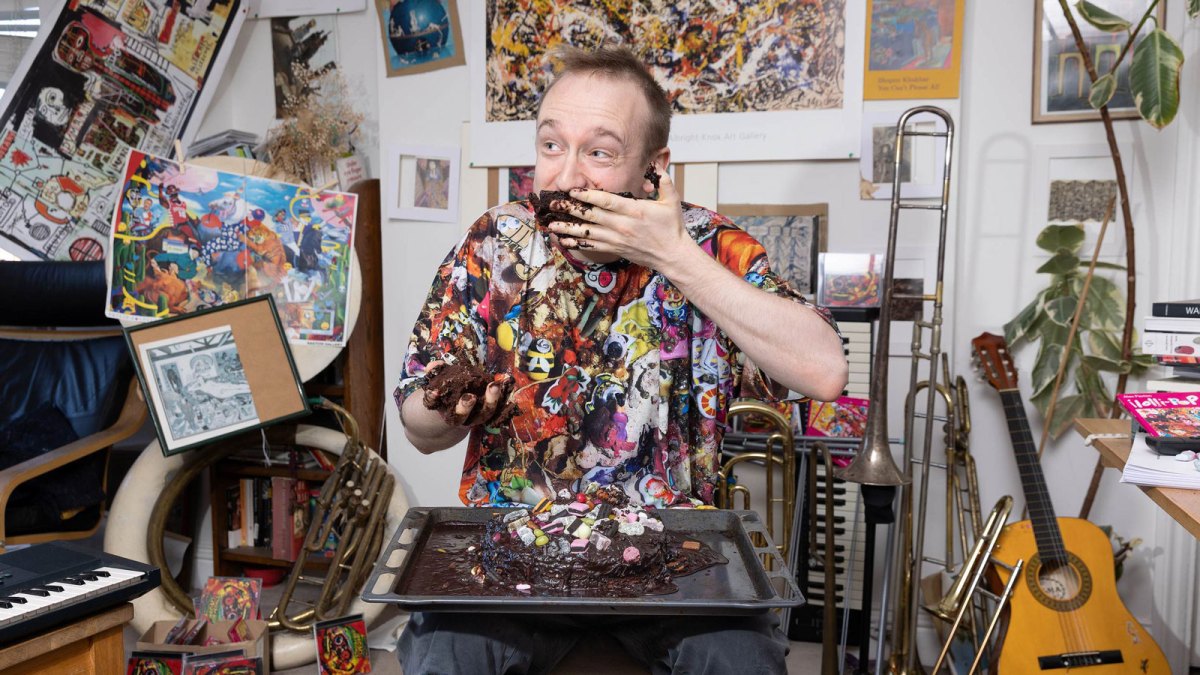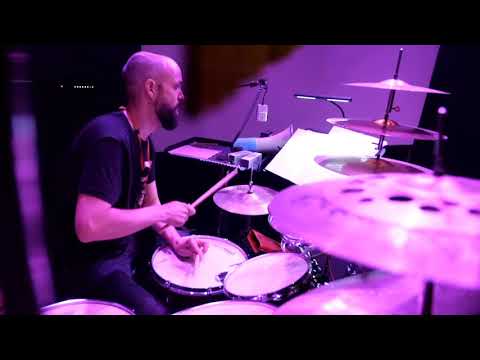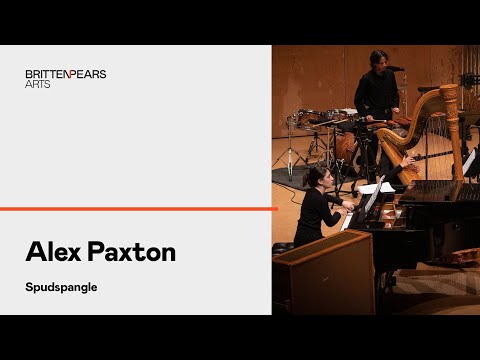Composer, improviser, and trombonist Alex Paxton has had a busy few months. Between winning both this year’s Ernst von Siemens Composer’s Prize and Paul Hindemith Prize, preparing for the release of his upcoming album “Happy Music for Orchestra” on Delphian Records, and commissions for Riot Ensemble, Nouvel Ensemble Contemporain, and Ensemble Modern, it felt like a privilege for both of us to spend a gloomy London afternoon drinking tea in a board game café.
“I’m very grateful that these institutions and festivals felt they’re able to commission me, I feel really lucky,” Paxton tells me. Over the course of numerous commissions and three studio albums, Paxton’s music—from the free jazz-tinged “Music for Bosch People” to the uncompromising intensity of “ilolli-pop,” from his talents as a “monster improviser” (Bandcamp) to his large-scale childrens’ operas—has stood in defiance of traditional stylistic boundaries. For me, central to Paxton’s joyously maximalist aesthetic is an almost childlike innocence and playfulness present in so much of his work, a topic we discussed alongside his recent projects, his approach to performance, and achieving musical euphoria.
VAN: You’ve been bouncing a lot between the UK and Germany for various commissions and performances. What kinds of projects have you been doing lately between the two countries?
Alex Paxton: I just did this piece for the Riot Ensemble that was performed at [Berlin contemporary music festival] MaerzMusik, called “Blue-Chew Cheerio Earpiece.” This is the latest one in a kind of family of pieces I’ve written in the last year, that started with “Car-Pig” for [pianist] Zubin Kanga—that’s also coming out later this month—and then “Shrimp BIT Babyface” for Nouvel [Ensemble Contemporain] and Riot Ensemble, and a piece called “Meanie” that I wrote for the London Sinfonietta. They’ve had an increasing presence of groove music—“Blue-Chew” is the most groove music-y piece I’ve written for a contemporary music ensemble.
You’ve mentioned this focus on groove music. Why have you chosen to focus on this theme recently, and what has thematically connected these pieces?
Groove music has always been an important part of my work. But most of my music isn’t groove music, in the sense that composers like Carla Bley, or Charles Mingus, or Laura Jurd are groove music composers—[where] the central intelligence of that music is in the groove itself. In the last two years, I’ve slowly been writing a proper groove music album on the backburner—I’m calling it my “jazz album”—for trombone, keys, and drums. I think that fired me up for groove music a bit more, and “Blue-Chew” is translating some of those feelings into a new music ensemble context.
Have you felt any sort of conscious pull towards this kind of cross-style pollination?
I don’t think in styles. I just write music. I just write tunes, really. I’m aware of the stylistic influence of the finished product, but I don’t think “this is gonna be a jazzy bit, or be influenced by another type of hashtag music.” In one sense, the creativity feels like it’s a river, and I dip into it. So it makes sense that a clump of pieces that I write in a specific time have a certain feel.
How does your upcoming album “Happy Music for Orchestra” relate to your previous two records, “ilolli-pop” and “Music for Bosch People”?
I don’t think in themes. I do think in feelings, but I don’t think in words in feelings. The qualities that those pieces have… It’s a bit more of an unplugged album. It’s almost entirely acoustic sounds, rather than electronic sounds. It’s a bit more classical—writing for classical instrumentalists, and orchestral musicians—as opposed to contemporary classical specialists.
These three albums are kind of a triptych. I made them over a similar time. “Bosch People” is written for individual musicians, originally put-together ensembles, and it’s the most electronic-heavy; “ilolli-pop” is written for contemporary classical specialist musicians; and then “Happy Music for Orchestra” is written for musicians who work in classical music, and have a different set of feeling, traditions, and interpretations.
Your piece Water Music,” for Beibei Wang, uses water percussion…
Water is such a fantastic, rich sound. We’re used to hearing water, anyone that’s had a bath in their life is used to hearing that, [but] it’s such a complex noise. For me, it’s inspired by listening to noise music [and] field recording music; there’s one piece by Annea Lockwood where she’s mic-ing up a buoy. And also, there are some beautiful recordings of the Baka tribe, who are known for their complex polyphony and aural tradition. There’s some stuff online of them collecting water, fishing, and having these really rhythmical [movements]—which is really hard to do in water, because it gives you so much friction back. It’s so hard to get something [like that] to groove. But Beibei manages it.
There’s something playful about that approach. We’ve talked before about performance as play—how did you and Wang explore this idea in your collaboration?
It was really nice that Beibei and I had a relationship in musical Play—with a capital P— beforehand. We even had jams where she’s playing water percussion, and I played water-based trombone sounds. I felt that we were building upon that relationship. I gave her sound worlds to occupy, for a certain length of time, and she was existing as a playful entity in that space, and able to react to the sounds that are happening in the orchestra.
What does the term Play mean for you, both as a composer and a performer?
That is everything to me. Play is a really important part of the improvised traditions that I feel closest to. It’s a really important part of creativity in jazz, and great American Black music. But also, I think it’s an important part of most music that has been made by humans ever. Even classical music, at its best or most “cooked,” is playful. Baroque music, and older musics that feel a little bit closer to an aural tradition, would recognize a sense of Play within a specific musical language.
Play is not just something that children do. To me, this is the essence of us building relationships with each other. If you listen to conversations—or observe behaviors of—people who are close, intimate, and have profound relationships with each other, you couldn’t label it to a specific type of content, or conversational or physical activity. It’s about the spirit of Play inhabiting a relationship between these things. And this is why my favorite art also has these tropes of Play, and I find this attractive because this is what is attractive about human relationships.
The latest from VAN, delivered straight to your inbox
The shared language of music is being used to build those connections.
And that feeds back into the music. The lovely thing about creating music in a truly spontaneous setting, is that, similarly to conversation, you can go to places that you would never go to on your own. Do things I would never do if I was just at my desk. In the same way that any thinking person can provoke, challenge, and grow their thoughts with interaction from somebody else. I think this is the same in Play. But I don’t think what I’m saying is terribly innovative. I think most people feel friendships work this way—good friendships, anyway.
Are these feelings consciously present in your compositional process?
What we’re talking about now is all just a kind of abstract feeling that I think my music is connected to. But I’m not using my music as some kind of research tool to connect things. I’m not looking to make conclusions about that—though I don’t mind if anybody else wants to. The music is the product, for me. And the feeling of being in that music as a performer, or listener—being in the same space as those sounds.
On the subject of this most recent album, “Happy Music for Orchestra,” were there any particular feelings that this set of pieces was aiming to convey, and how did you channel them?
It’s not all happy, and it’s not all orchestral. But I felt it was a good title for this family of pieces. I don’t think about the feelings I create so specifically as to give them adjectives. I think the feelings that happen when listening to my music are just what people feel when they listen to it. Any word is as good as any other.
But it gives me a feeling of happiness, I feel ecstatic by it. Maybe I am following some feelings of euphoria. I don’t expect that euphoria is the same for everyone. It is for me, but if it isn’t for somebody else, it’s still an interesting sonic experience for them.
Are these feelings more present for you on the performing side, when you’re on stage and working alongside ensembles?
Yes, but it’s not a sweetshop euphoria. I’m working very hard when I’m performing. It’s very physically exhausting—just like other physically exhausting things, it’s Work, with a capital W. But I love being in those spaces, and in those worlds. So I don’t know whether “euphoric” or “happy” are quite the right words, but it’s important. What I’m doing feels very meaningful to me, for sure; whether I’m performing or writing, it’s essential.
How does this relate to your compositional process?
I try to make my composition process as pleasant an experience as possible for me. I hate this narrative of the “struggling artist,” because being an artist in this society is such a privilege. Even if you make money from something else—like I did when I wrote this music—it’s such a privilege to do this, to make art. So the “struggling artist” narrative is horrible, really. It would be a lie to say I didn’t ever struggle, but I really love writing, and that’s why I spend so much time doing it. For me, this is freedom. Composing music, creating music, is the thing in this life that makes me feel most alive. I want to spend as much of my life doing it as possible. ¶



